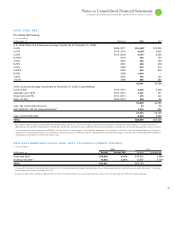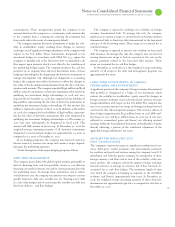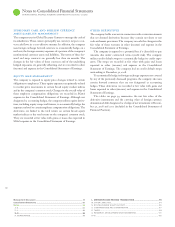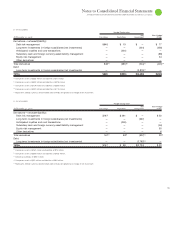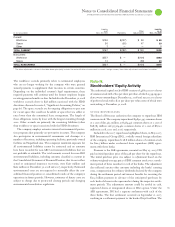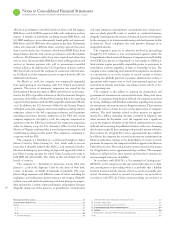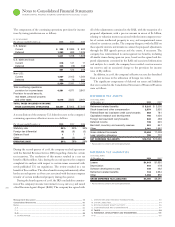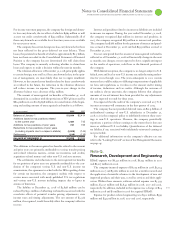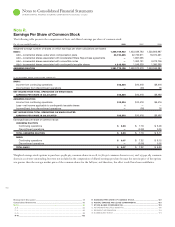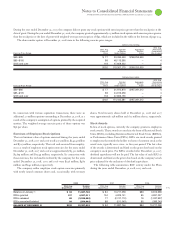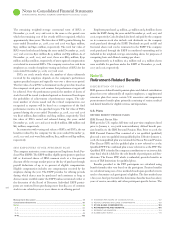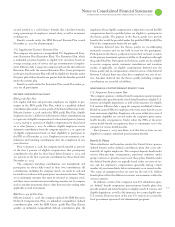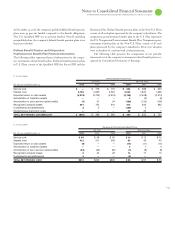IBM 2008 Annual Report Download - page 101
Download and view the complete annual report
Please find page 101 of the 2008 IBM annual report below. You can navigate through the pages in the report by either clicking on the pages listed below, or by using the keyword search tool below to find specific information within the annual report.
Notes to Consolidated Financial Statements
INTERNATIONAL BUSINESS MACHINES CORPORATION and Subsidiary Companies
least quarterly and provisions are taken or adjusted to reflect the
impact and status of settlements, rulings, advice of counsel and other
information pertinent to a particular matter. Any recorded liabilities
including any changes to such liabilities for the year ended December
, , were not material to the Consolidated Financial Statements.
Based on its experience, the company believes that the damage
amounts claimed in the matters previously referred to are not a
meaningful indicator of the potential liability. Claims, suits, investiga-
tions and proceedings are inherently uncertain and it is not possible
to predict the ultimate outcome of the matters previously discussed.
While the company will continue to defend itself vigorously in all
such matters, it is possible that the company’s business, financial
condition, results of operations or cash flows could be affected in any
particular period by the resolution of one or more of these matters.
Whether any losses, damages or remedies finally determined in
any such claim, suit, investigation or proceeding could reasonably
have a material effect on the company’s business, financial condition,
results of operations or cash flows will depend on a number of vari-
ables, including the timing and amount of such losses or damages; the
structure and type of any such remedies; the significance of the impact
any such losses, damages or remedies may have on the Consolidated
Financial Statements; and the unique facts and circumstances of the
particular matter which may give rise to additional factors.
The company’s extended lines of credit to third-party entities include
unused amounts of $, million and $, million at December
, and , respectively. A portion of these amounts was avail-
able to the company’s business partners to support their working
capital needs. In addition, the company has committed to provide
future financing to its clients in connection with client purchase
agreements for approximately $, million and $, million at
December , and , respectively. The change over the prior
year is due to increased signings of long-term IT infrastructure
arrangements in which financing is committed by the company to
fund a client’s future purchases from the company.
The company has applied the provisions of FIN , “Guarantor’s
Accounting and Disclosure Requirements for Guarantees, Including
Guarantees of Indebtedness of Others,” to its agreements that con-
tain guarantee or indemnification clauses. These provisions expand
those required by SFAS No. , by requiring a guarantor to recognize
and disclose certain types of guarantees, even if the likelihood of
requiring the guarantor’s performance is remote. The following is a
description of arrangements in which the company is the guarantor.
The company is a party to a variety of agreements pursuant to
which it may be obligated to indemnify the other party with respect
to certain matters. Typically, these obligations arise in the context of
contracts entered into by the company, under which the company
customarily agrees to hold the other party harmless against losses
arising from a breach of representations and covenants related to
such matters as title to assets sold, certain IP rights, specified environ-
mental matters, third-party performance of nonfinancial contractual
obligations and certain income taxes. In each of these circumstances,
payment by the company is conditioned on the other party making a
claim pursuant to the procedures specified in the particular contract,
which procedures typically allow the company to challenge the other
party’s claims. Further, the company’s obligations under these agree-
ments may be limited in terms of time and/or amount, and in some
instances, the company may have recourse against third parties for
certain payments made by the company.
It is not possible to predict the maximum potential amount of
future payments under these or similar agreements due to the condi-
tional nature of the company’s obligations and the unique facts and
circumstances involved in each particular agreement. Historically,
payments made by the company under these agreements have not
had a material effect on the company’s business, financial condition
or results of operations.
In addition, the company guarantees certain loans and financial
commitments. The maximum potential future payment under these
financial guarantees was $ million and $ million at December ,
and , respectively. The fair value of the guarantees recognized
in the Consolidated Statement of Financial Position is not material.
Note P.
Taxes
($ )
For the year ended December : 2008 2007 2006
Income from continuing operations
before income taxes:
U.S. operations $ 8,424 $ 7,667 $ 7,277
Non-U.S. operations 8,291 6,822 6,040
TOTAL INCOME FROM CONTINUING
OPERATIONS BEFORE
INCOME TAXES $16,715 $14,489 $13,317
The continuing operations provision for income taxes by geographic
operations is as follows:
($ )
For the year ended December : 2008 2007 2006
U.S. operations $2,348 $2,280 $2,413
Non-U.S. operations 2,033 1,791 1,488
TOTAL CONTINUING OPERATIONS
PROVISION FOR INCOME TAXES $4,381 $4,071 $3,901


